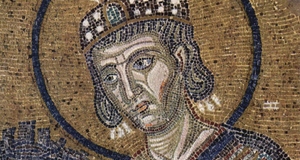Opinion:Universal Grace: Early Christian Texts Focused on Conversion
By
2009, Vol. 1 No. 12 | pg. 1/1
KEYWORDS:
I will oppose fervently anyone who argues that the relative success of the Christian church owes anything to “uniqueness,” at least as far as theology goes. Christianity is not unique, not in its conception of God, not in its ideas about truth, not even in its Christ. The credit lies conspicuously elsewhere: in the energy it dedicated to developing a deep tradition of conversion. Christianity turned conversion into something enormous, made it ring almost precisely in tune with divine grace. In the early writings conversion came to be described, through the actual experience of it and through all its potential suitors, as both the most defining piece of human lifetime (in a personal sense) and the ultimate goal of God’s glory (in a worldwide sense). In the Gospel of Matthew Jesus says, “No one after lighting a lamp puts it under a bushel basket, but on a lampstand, and it gives light to all the house” (5:14-15). So it must be with his word. Christian conversion must be understood above all as a gift of God, a bestowal of grace, for “God is the author of this change, who by his spirit puts repentance, faith, love, and every grace into the soul”(Cruden 1958, 36). The human soul must take responsibility for accepting God but not credit for doing so; just as God breathed into it its first life, so now in holy conversion does he breathe in its second life—he, and only he. Where this is concerned people create their own hardships, as God never rests. He is always ready for the willing soul, as Augustine writes, “And Thou dost never part from us, yet with difficulty do we return to thee” (Augustine, 146).In fact Augustine is most useful in understanding the early Christian concept of the conversion experience because he embodies it perfectly, in all its sweet irony. In Confessions Augustine details the torturous path to his conversion, using imagery of chains and darkness and depths of pits; and all the while salvation hovers just as the edge of his peripheral vision. Therein lies the catch. As the human soul imagines it turns its eye towards Christ, it truly turns away, and Christ follows at the same frustrating distance as before. For it is within the nature of the human soul to cause suffering (to itself and others) in order that salvation may be felt more gloriously. Luke in his Gospel relates the parable of the prodigal son, who must live a life of reckless sin and ruin before he returns to his father in the throes of repentance—but his father rejoices all the more fervently because “he was dead and has to life; he was lost and has been found” (15:32). God does not interfere with will, but only offers the gift of Christ’s grace, “the free and eternal love and favor…the spring and source of all the benefits we receive from him” (Cruden 1958, 138), and in the event of its acceptance and reception humanity can do nothing but stand in awe. In his telling of the convert Victorinus, formerly a flamboyant pagan, Augustine wonders, “O Lord, O Lord, who dost bow down Thy heavens and descend, dost touch the mountains and they smoke; by what means didst Thou find Thy way into that heart?” (Sheed, 143). Truly he can only marvel at the enormity of this thing, of this divine gift of illumination; in John 8:12 Jesus says, “I am the light of the world,” and by this light people find all truth and all direction (Barker and Kohlenberger 1994, 323) and, most importantly, forgiveness for sins (Wall 2002, 22). Then God’s gift to the convert, characterized in early Christian tradition as so, so simply there—but invisible to hard hearts—is furthermore all-encompassing; it knows no limits; it manifests itself in each minute detail, and “[t]his penetration of divine grace into human life symbolizes the biblical conception of salvation—one that reroutes a battered and broken creation back towards the original intentions of the Creater…” From this we have already a taste of the power of the conversion experience. Profundity is written into its Christian definition, as it is the act of “turning or total change [my italics] of a sinner from his sins to God” (Cruden 1958, 36) and of “turning from one way of living to a different way of living” (Sakenfeld 2006, 728). But for a true jolt of gracious thunder one must look to the conversion story of Saul (or Paul), a Jewish persecutor of Christians until on his path to Damascus one day he is confronted by the voice of Christ. The story goes that “Saul got up from the ground, and though his eyes were open, he could see nothing” (Acts 9:8) and when his conversion is complete after three days “something like scabs fell from his eyes, and his sight was restored” (Acts 9:18). It is hard to overstate the implications here of the brilliance of the awakening to grace, if it is so that the sinner is blinded by its flash for three days. While the instant of conversion is never the end of the story—for there is much work to be done—it is undoubtedly the most important in its long-lasting impact, as “[t]ime would be needed to heal [Saul’s] emotions and work out the implications of his experience…in this supreme revelational encounter, Saul received a new perspective on divine redemption, a new agenda for his life, and the embryonic elements of his new Christian theology” (Barker and Kohlenberger 1994, 432). In other stories of conversion in the New Testament such loss of faculty for teaching or persuasive purposes is not altogether uncommon. Zechariah is struck dumb before the birth of his son John the Baptist turns him into a proper believer (Luke 1:18-20; 59-64), and Paul blinds the magician Bar-Jesus to win the conversion of Sergius Paulus (Acts 13: 5-12). Either way is evidence to the effect the experience presents to human life, and perhaps is also necessary to modern readers if they are to grasp in any way the gravity of conversion at this turbulent time. But to those witnessing first-hand the development of this tradition, details now more subtle were eyebrow-raising to say the least. In Acts 2 Peter gives a speech to a large Jewish crowd, and the result is stated with seeming casualness as, “and that day about three thousand persons were added.” Not only was this understood as an alarming number to a budding congregation, but it was not custom for Jews born into the faith to be baptized (the practice was reserved for Gentile converts), so baptism in Jesus’ name “was traumatic and significant for them in a way we in our mildly christianized culture have difficulty understanding” (Barker and Kohlenberger 1994, 396). The power of the conversion experience as described by Augustine is meanwhile far more obvious, even to those for whom the term has lost its edge. In relating the awakening tale told to him by his mentor, he describes the convert in question as “changed inwardly, where You alone could see…while he was reading and his heart thus tossing on its own flood, at length he broke out in heavy weeping, saw the better way and chose it for his own”(Sheed, 151). The same force of divine muscle that struck Saul blind, as lightning, now pushes tears down this man’s face, as flood. How is it that sinners like Saul, that sinners like Augustine himself, who lived his life as a stream of self-professed most vulgar transgressions against God, may feel suddenly that “a light of utter confidence shone in all my heart, and all the darkness of uncertainty vanished away.” Wee see that the force of conversion must be strong, its impact must be cataclysmic, if it is to turn the tides of evil will, if it is to unravel a lifetime of twisted soul-workings—that is a lot of backlash. For Augustine says, “Do not many from a deeper pit of blindness than Victorinus come back to Thee, enlightened by that light in which they receive from Thee the power to be made Thy sons?” (Sheed, 146). The force must be strong, because no one is beyond salvation. That is to say, no one, whether Jew or Gentile, is beyond salvation; for if the early Christian writings represent anything true about the development of its philosophy, the conversion movement, per se, did not seek to create the sort of exclusive club that Judaism tended toward. Instead it strove to sweep all the world beneath its redemptive wing. And it started where it began: among the Jews. The NIV Bible Commentary finds it significant that Saul found Christ without the usual Jewish formalities associated with salvation, in “a manner that did not make him dependent on the Jerusalem church for either his conversion or call” (Barker and Kohlenberger 1994, 343). But I think it is far more significant that God’s most influential missionary was indeed a Jew. This is highly symbolic, that the world was to be converted by a Jew; there is no path to Christ but through the God of Israel. In Romans 1:16, Paul proclaims, “For I am not ashamed of the gospel; it is the power of God for salvation to everyone who has faith, to the Jew first and also to the Greek,” and the note on this verse astutely points out that his vantage point here is unapologetically Jewish. In Acts, too, when Paul arrives in Rome, his chief aim is not the pagans but his fellow Jews (Wall 2002, 9). The nature of conversion in the early Christian church was therefore not such that origins were to be forgotten or inconvenient reminders purged, though rampant anti-Semitism in Rome at the time may have wished it so (Wright 2002, 407). It is instead as the Lord commanded and Paul quotes, “I have set you to be a light for the Gentiles, so that you may bring salvation to the ends of the earth” (Acts 13:47). The conversion of the Jews was essential first and foremost in the early church because it was what God had willed—God had meant for the resurrection to be affirmation of the Israelite God, a clear sign of his keeping with the covenant, which was “established in the first place in order to deal with the problem of the world as a whole.” Paul seemed to believe this with all his heart, for both as a character in Acts and as the author of letters he does not shy from the steadfast belief in the conversion of the Jews, and the conversion of them first; despite his harsh criticisms of them, “he is not motivated by a desire to belittle his nation. Rather, he seeks their highest good” (Barker and Kohlenberger 1994, 534). The apparent venom directed toward the Jews in the early Christian writings is in fact not altogether removed from their subjection to the wrath of God in the Old Testament; for as they deserve rebuke then for not observing the covenant and needed it for turning them back towards God, so also do they deserve and need it here—or that was the Christian stance. Paul wrote in Romans that “real circumcision is a matter of the heart—it is spiritual and not literal” (2:29) and “For not all Israelites truly belong to Israel, and not all of Abraham’s children are his true children” (9:6-7). The reason conversion is so desperately necessary now is that Jews have become complacent in their covenant with God; however, the reason the missionaries have had to move past the Jews to the Gentiles is not ‘out of mere frustration that [Paul’s] fellow Jews had refused it, as a kind of displacement activity” (Wright 2002, 401), but because the grace of God must expand rapidly after the miracle of the resurrection, and it cannot wait for the change of heart of every Jew. In this exciting epoch of rapid enlightenment, time cannot be made for snobbery or hesitancy from anyone, from any race or nation. It is in this spirit that “Gentiles, who did not strive for righteousness, have attained it… through faith; but Israel, who did strive for righteousness based on the law, did not succeed in fulfilling that law” (Rom 9:30-31). Conversion to Christ, conversion to Christ—this is mantra of the developing congregation. And with open arms the missionaries go to the Gentiles. It begins in Acts during the persecution in Jerusalem, when “those who were scattered went from place to place, proclaiming the word” (8:4). Philip goes to Samaria, where dwell, according to the note on these verses, bitter rivals of the Jews—representing “a significant advance in the outreach of the Gospel” (Barker and Kohlenberger 1994, 426). The conversion of the Gentiles is not undertaken lightly but in accordance with the most solemn command from the Lord. Peter receives a vision from God in a dream, in which he is shown a sheet bursting with “unclean” creatures (according to Jewish law), but who God explains are clean because he created them—then he brings them up into heaven (Acts 10:10-16). Peter takes this to mean, as his readership is meant to, that there is nothing “wrong” with the Gentiles, that in truth “God shows no partiality” (Acts 10:34). God’s creation gave life to all beings, and so all beings may find redemption in him; and it was the position of the missionaries that Gentiles could therefore be brought into the ancient traditions of Israel through the grace of Jesus, that “The basic requirements of the law are stamped on human hearts” (Barker and Kohlenberger 1994, 532), as all are made equally in the image of the Creator. The visionaries of the early tradition sought peace in conversion. Differences would be accepted easily in the name of Christ, which would be all that remained to matter; kosher laws, for example, need be no reason for conflict, as Paul wrote in Romans, “For the Kingdom of God is not food and drink but righteousness and peace and joy in the Holy Spirit” (14:17). Of course their vision overlooked reality. Of course the entire world could not be redeemed by a single miraculous story of hearsay; of course the convertors harbored their own brand of tunnel-vision obstinacy. But to them then in their wild string of instants conversion would “reflect God’s intention that Jew and Gentile come together as one worshipping body in Christ” (Wright 2002, 406). Conversion would end the violence, as it had done with Saul; conversion would quiet the tumult of Augustine’s soul. Conversion would be peace. ReferencesAugustine, Confessions. Translated by F.J. Sheed. Edited by Michael P. Foley. Sheed & Ward Inc., 1942. Reprinted by Hackett Publishing Company, Inc., 2006. Barker, Kenneth L. and John Kohlenberger III. NIV Bible Commentary Vol. 2: New Testament. USA: Zoderman Publishing House, 1994. Cruden, Alexander. Cruden’s Dictionary of Bible Terms. London: Pickering & Inglis LTD., 1958. Sakenfeld, Katharine Doob, ed. The New Interpreter’s Dictionary of the Bible A-C, Vol.I. Nashville: Abingdon Press, 2006 Wall, Robert W. “The Acts of the Apostles—Introduction.” In The New Interpreter’s Bible, Vol. X, edited by Leander E. Keck, 3-32. Nashville: Abingdon Press, 2002. Wright, N.T. “The Letter to the Romans—Introduction.” In The New Interpreter’s Bible, Vol.X, edited by Leander E. Keck, 395-408. Nashville: Abingdon Press, 2002. Suggested Reading from Inquiries Journal
Inquiries Journal provides undergraduate and graduate students around the world a platform for the wide dissemination of academic work over a range of core disciplines. Representing the work of students from hundreds of institutions around the globe, Inquiries Journal's large database of academic articles is completely free. Learn more | Blog | Submit Latest in Opinion |














